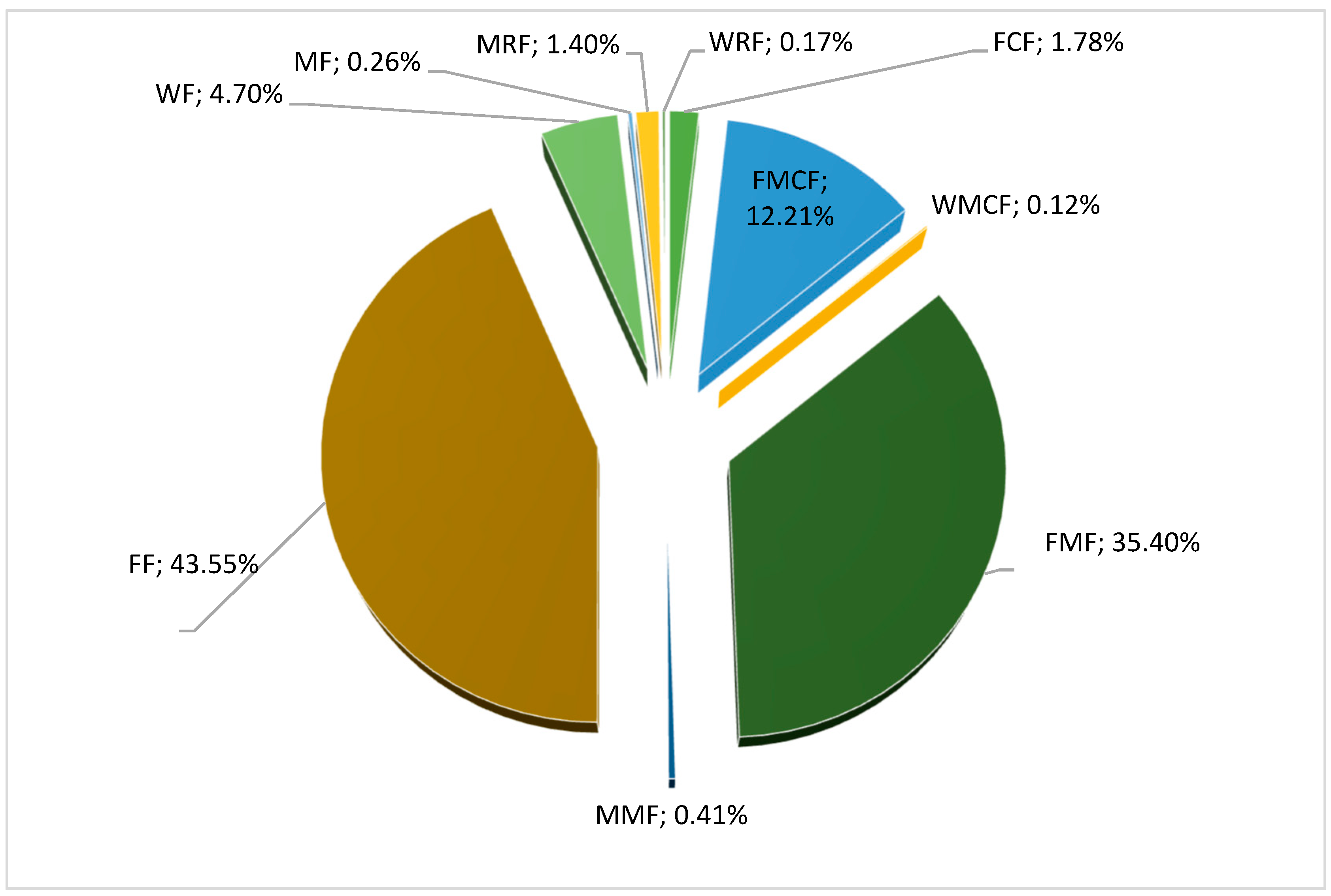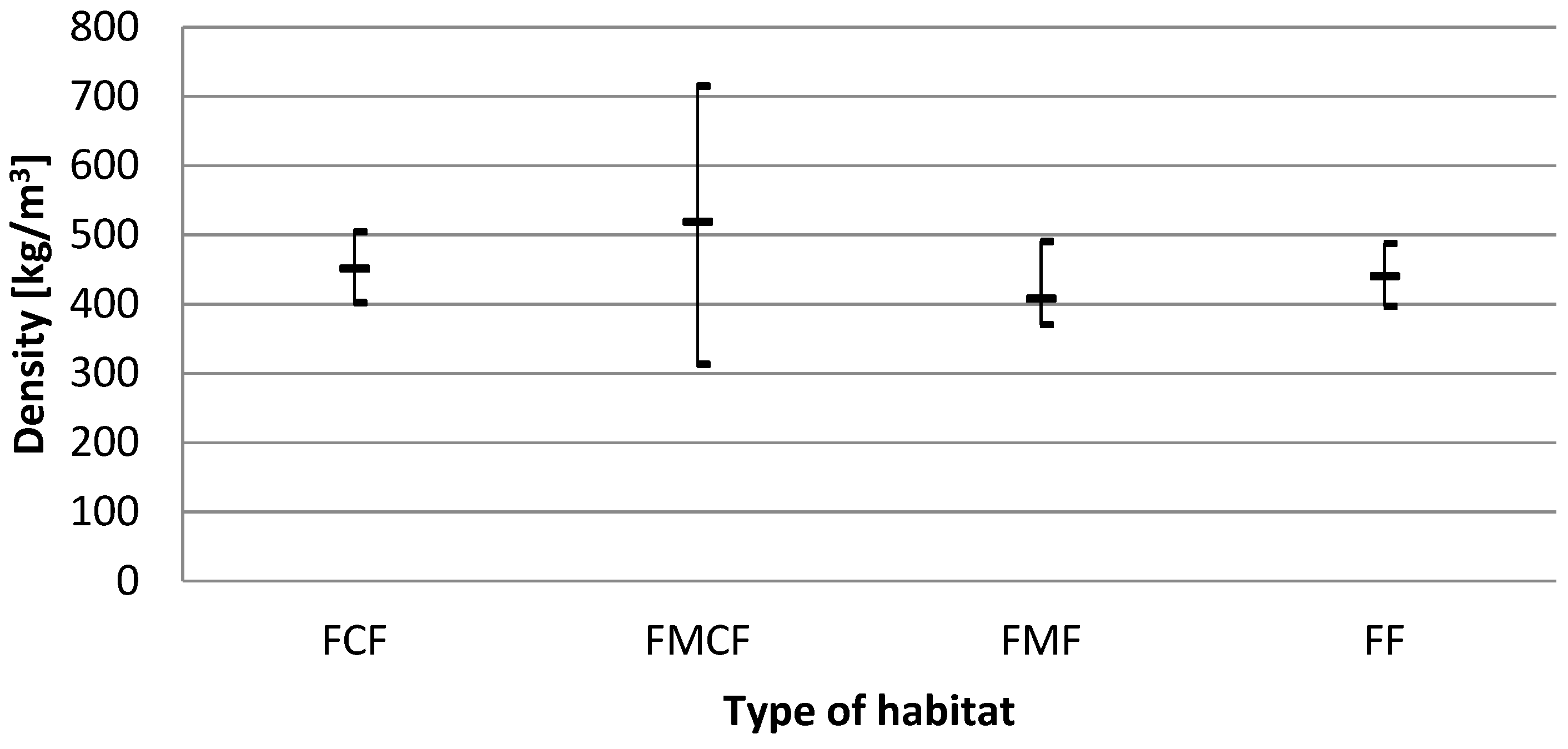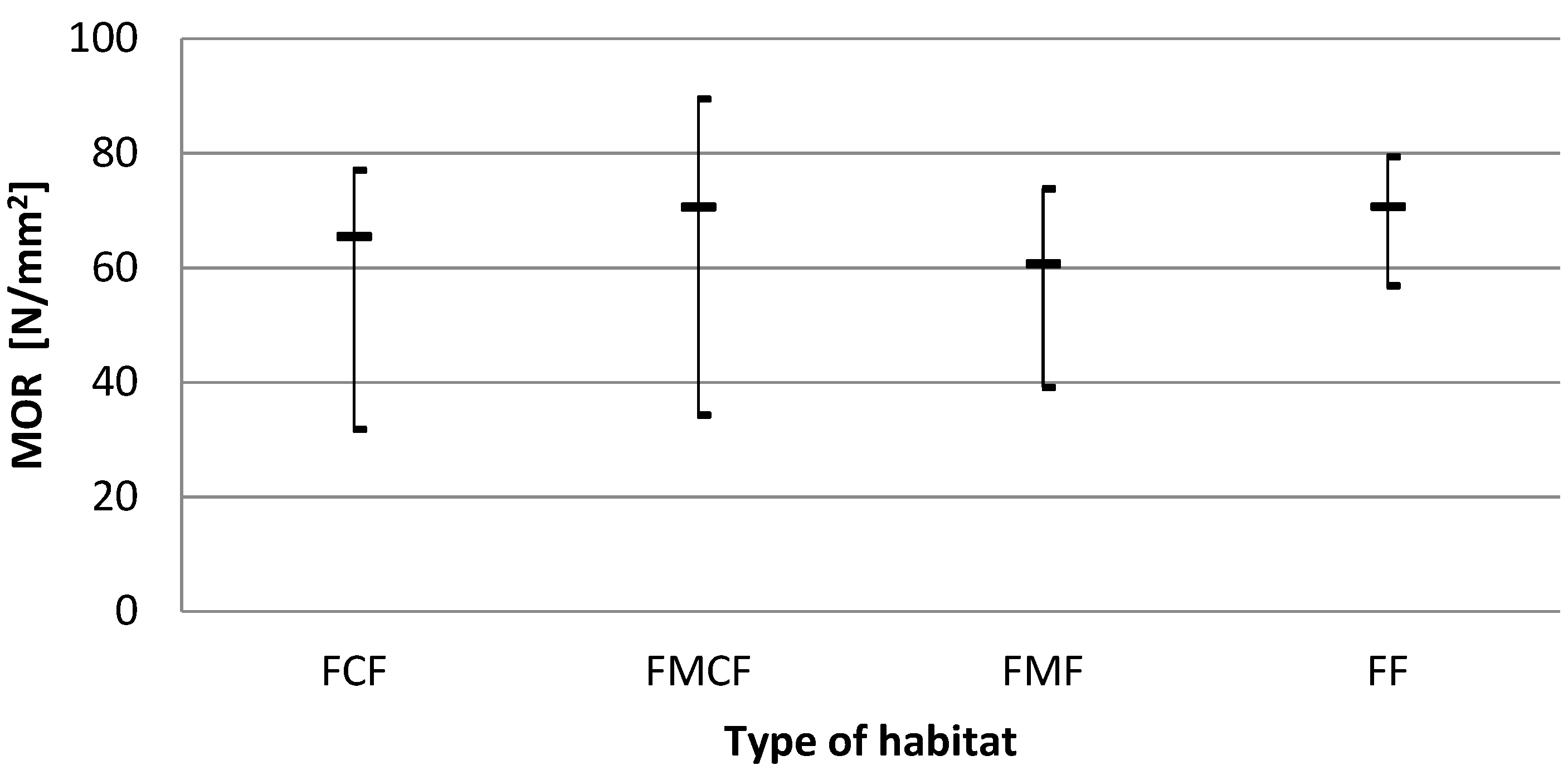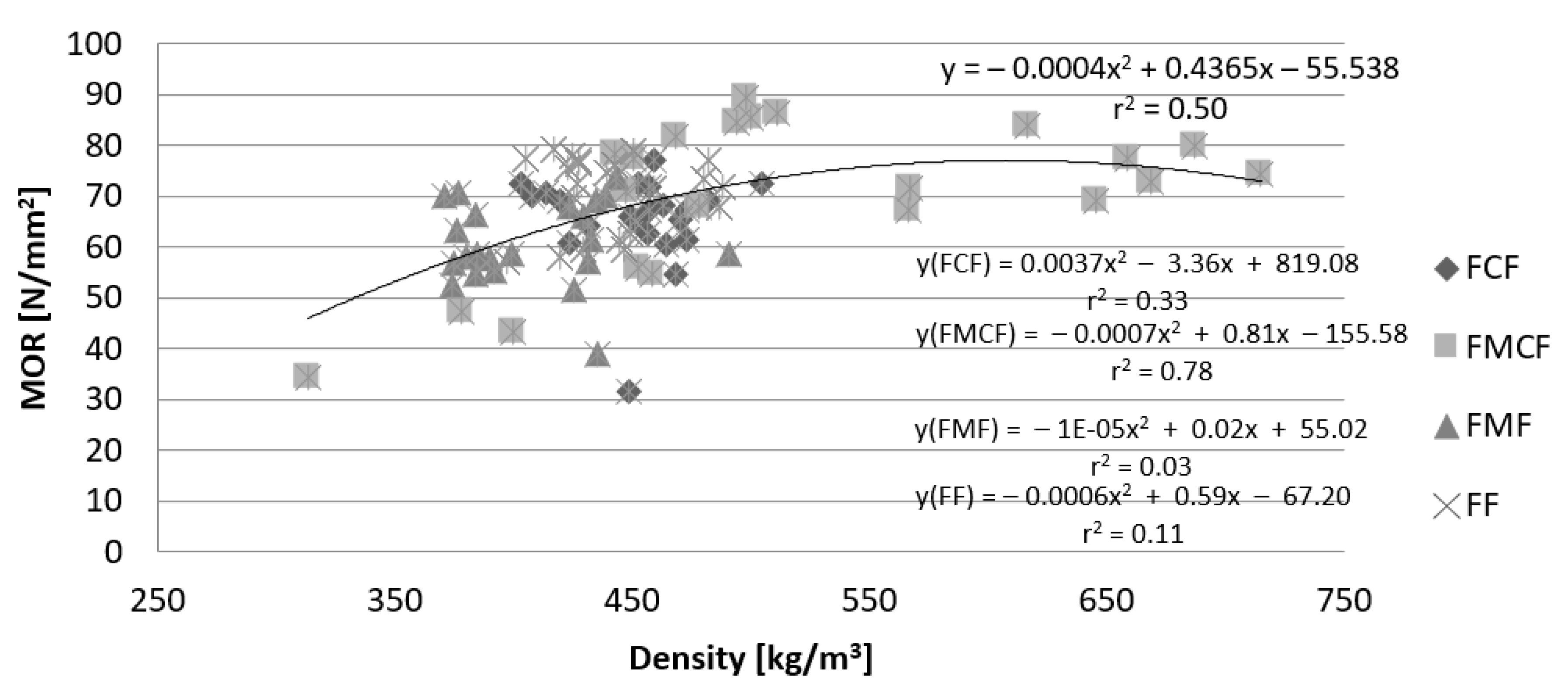The Influence of Habitat Conditions on the Properties of Pinewood
Abstract
:1. Introduction
- coniferous forests (extremely poor soils): dry (DCF) water level (w.l.) less than 2.5 m below ground level (b.g.l.); fresh (FCF) w.l. 1.8–2.0 m b.g.l., wet (WCF) w.l. 0.4–0.8 m b.g.l. and marshy (MCF) w.l. 0.2–0.5 m b.g.l.;
- mixed coniferous forests (poor soils): fresh (FMCF) w.l. less than 1.8 m b.g.l.; wet (WMCF) w.l. 0.5–1.8 m b.g.l.; marshy (MMCF) w.l. 0.2–0.5 m b.g.l. and surface water occurrence 1–5 months;
- mixed forests (medium fertile soils): fresh (FMF) under moderate ground w.l. less than 1.8 m b.g.l.; wet (WMF) under moderate ground w.l. 0.5–1.8 m b.g.l.; marshy (MMF) under moderate ground w.l. 0.2–0.5 m b.g.l.;
- forests (fertile soils): fresh (FF) under the short-term influence of w.l. less than 1.8 m b.g.l.; wet (WF) under moderate ground w.l. 0.5–1.8 m b.g.l.; marshy (MF) shallow water (0.0–0.5 m b.g.l.), periodically flooding, i.e., alder carr.
2. Materials and Methods
- FCF—267 f located in the forest district of Wycinki, forest stand aged 123 years;
- FMCF—176 b located in the forest district of Przyjezierze, forest stand aged 111 years;
- FMF—206 d located in the forest district of Wysoki Most, forest stand aged 86 years;
- FF—35 f located in the forest district of Kurzebiela, forest stand aged 122 years.
3. Results
4. Discussion
5. Conclusions
- The type of forest habitat influenced the average strength of pinewood. The highest variability of the average flexural strength was observed for the FMF habitat (SD 14.5 N/mm2). The wood from this weak habitat was characterised by the lowest strength (60.7 N/mm2) and belonged to the second homogeneous group according to the Tukey HSD test;
- The wood from the FMCF, FCF and FF habitats was in the same homogeneous group. At the same time, the wood from the FCF weakest habitat belonged to the first and second homogeneous groups and was characterised by the second lowest average strength;
- The type of forest habitat influenced the average density of wood. The wood from the FMCF habitat was characterised by noticeably different density. It belonged to the second homogeneous group and had the highest average density (519 kg/m3);
- Height in habitat quality have resulted in a decrease in average pinewood density;
- Increasing habitat quality promotes a decrease in the standard deviation for the distribution of static bending strength scores of pinewood;
- In the strength classification, the highest lower strength value was confirmed for the best fresh forest (FF) habitat.
Author Contributions
Funding
Data Availability Statement
Conflicts of Interest
References
- Kliczkowska, A.; Zielony, R.; Czępińska-Kamińska, D.; Kowalkowski, A.; Sikorska, E.; Krzyżanowski, A.; Cieśla, A.; Czerepko, J. Siedliskowe Podstawy Hodowli Lasu; Polskie Towarzystwo Gleboznawcze: Warszawa, Poland, 2003; pp. 5–52. [Google Scholar]
- Dieler, J.; Uhl, E.; Biber, P.; Müller, J.; Rötzer, T.; Hans Pretzsch, H. Effect of forest stand management on species composition, structural diversity, and productivity in the temperate zone of Europe. Eur. J. For. Res. 2017, 136, 739–766. [Google Scholar] [CrossRef]
- Krakau, U.K.; Liesebach, M.; Aronen, T. Scots Pine (Pinus sylvestris L.). For. Tree Breed. Eur. 2013, 25, 267–323. [Google Scholar]
- Pretzsch, H.; Rais, A. Wood quality in complex forests versus even-aged monocultures: Review and perspectives. Wood Sci. Technol. 2016, 50, 845–880. [Google Scholar] [CrossRef]
- Assmann, E. The Principles of Forest Yield Study: Studies in the Organic Production, Structure, Increment, and Yield of Forest Stands; Pergamon Press: Oxford, UK, 1970. [Google Scholar]
- Antonova, G.F.; Stasova, V.V. Effects of environmental factors on wood formation in Scots pine stems. Trees 1992, 7, 214–219. [Google Scholar] [CrossRef]
- Burdon, D.R.; Kibbelwithe, R.P.; Walker, J.C.F.; Megraw, R.A.; Evans, R.; Cown, D.J. Juvenile versus mature wood: A new concept, orthogonal to corewood versus outerwood, with special reference to Pinus radiata and Pinus tadea. For. Sci. 2004, 50, 399–415. [Google Scholar] [CrossRef]
- Jakubowski, M. The share of sapwood, heartwood juvenile wood and mature wood in pine stems (Pinus sylvestris L.) in relation to site conditions. Sylwan 2004, 148, 16–24. [Google Scholar] [CrossRef]
- Bembenek, M.; Karaszewski, Z.; Kondracki, K.; Łacka, A.; Mederski, P.S.; Skorupski, M.; Strzeliński, P.; Sułkowski, S.; Wegiel, A. Value of merchantable timber in Scots pine stands of different densities. Drewno 2014, 57, 133–142. [Google Scholar]
- Krzosek, S.; Burawska-Kupniewska, I.; Mańkowski, P. The Influence of Scots Pine Log Type (Pinus sylvestris L.) on the Mechanical Properties of Lumber. Forests 2020, 11, 1257. [Google Scholar] [CrossRef]
- Węgrzyn, M.H.; Kołodziejczyk, J.; Fałowska, P. Influence of the environmental factors on the species composition of lichen Scots pine forests as a guide to maintain the community (Bory Tucholskie National Park, Poland). Glob. Ecol. Conserv. 2020, 22, e01017. [Google Scholar] [CrossRef]
- Chytrý, M.; Hennekens, S.M.; Jiménez-Alfaro, B.; Knollová, I.; Dengler, J.; Jansen, F.; Landucci, F.; Schaminée, J.H.J.; Aćić, S.; Agrillo, E.; et al. European Vegetation Archive (EVA): An in-tegrated database of European vegetation plots. Appl. Veg. Sci. 2016, 19, 173–180. [Google Scholar] [CrossRef] [Green Version]
- Giannetti, F.; Barbati, A.; Mancini, L.D.; Travaglini, D.; Bastrup-Birk, A.; Canullo, R.; Nocentini, S.; Chirici, G. European forest types: Toward an automated classification. Ann. For. Sci. 2018, 75, 6. [Google Scholar] [CrossRef] [Green Version]
- Sikorska, E.; Lasota, J. Typologiczny system klasyfikacji siedlisk a fitosocjologiczna ocena siedlisk. Studia Mater. Cent. Edukac. Przyr.-Leśnej 2007, 9, 16. [Google Scholar]
- Brożek, E.; Zwydak, M.; Bujnowska, Z.; Zaremba, E.; Głuchowska, E.; Zamorska, B.; Kijewska, E. Atlas Gleb Leśnych Polski; Centrum Informacyjne Lasów Państwowych: Warszawa, Poland, 2010; pp. 45–461. [Google Scholar]
- Sensuła, B.; Wilczyński, S.; Opała, M. Tree growth and climate relationship: Dynamics of Scots pine (Pinus sylvestris L.) growing in the near-source region of the combined heat and power plant. Water Air Soil Pollut. 2015, 226, 220. [Google Scholar] [CrossRef] [Green Version]
- Lasota, J. Solis of forest site types in Żywiec region Part I. Forest sites at low elevations of the lower montane zone. Sylwan 2004, 148, 3–10. [Google Scholar] [CrossRef]
- Sewerniak, P. Impact of soil properties on site index class of Scots pine (Pinus sylvestris L.) stands in south−western Poland. I. pH, content of CaCO3, and properties concerning soil depth. Sylwan 2012, 156, 427–436. [Google Scholar] [CrossRef]
- Smal, H.; Olszewska, M. The effect of afforestation with Scots pine (Pinus silvestris L.) of sandy post-arable soils on their selected properties. II. Reaction, carbon, nitrogen and phosphorus. Plant Soil 2008, 305, 171–187. [Google Scholar] [CrossRef]
- Schoenholtz, S.H.; Van Miegroet, H.; Burger, J.A. Elsevier A review of chemical and physical properties as indicators of forest soil quality: Challenges and opportunities. For. Ecol. Manag. 2000, 138, 335–356. [Google Scholar] [CrossRef]
- Sewerniak, P.; Piernik, A. Regression models for impact of soil properties on site index class of Scots pine (Pinus sylvestris L.) stands in south−western Poland. Sylwan 2012, 156, 563–571. [Google Scholar] [CrossRef]
- Gaztelurrutia, M.R.; Oviedo, J.A.B.; Pretzsch, H. A review of thinning effects on Scots pine stands: From growth and yield to new challenges under global change. For. Syst. 2017, 26, eR03S. [Google Scholar]
- Kamperidou, V.; Terzopoulou, P.; Barboutis, I. Marginal lands providing tree-crop biomass as feedstock for solid biofuels. Biofules Bioprod. Biorefining 2021, 15, 1395–1405. [Google Scholar] [CrossRef]
- Gostołek, R.; Adamowicz, K. Wpływ siedliskowego typu lasu na miąższościowy współczynnik nasilenia trzebieży. Acta Sci. Pol. Silv. Colendar. Rat. Ind. Lignar. 2016, 15, 169–174. [Google Scholar] [CrossRef] [Green Version]
- Kuuluvainen, T. Conceptual models of forest dynamics in environmental education and management: Keep it as simple as possible, but no simpler. For. Ecosyst. 2016, 3, 18. [Google Scholar] [CrossRef] [Green Version]
- Pietrzykowski, M. Tree species selection and reaction to mine soil reconstructed at reforested post-mine sites: Central and eastern European experiences. Ecol. Eng. 2019, 142, 100012. [Google Scholar] [CrossRef]
- Woziwoda, B. Zróżnicowanie siedlisk i drzewostanów w lasach gminy Szadek. Biul. Szadkowski 2009, 9, 119–133. [Google Scholar]
- Oberhuber, W.; Stumboeck, M.; Kofler-Trees, W. Climate-tree-growth relationships of Scots pine stands (Pinus sylvestris L.) exposed to soil dryness. Trees 1998, 13, 19–27. [Google Scholar] [CrossRef]
- Klimek, A.; Rolbiecki, S.; Rolbiecki, R. Impact of chosen bare root nursery practices in Scots pine seedling quality and soil mites (Acari). Pol. J. Environ. Stud. 2008, 17, 247. [Google Scholar]
- Beker, C.; Blajer, K.; Jaszczak, R.; Turski, M. Ocena drzewostanów sosnowych na gruntach porolnych na przykładzie Nadleśnictwa Szczecinek. Acta Sci. Pol. Silv. Colendar. Rat. Ind. Lignar. 2016, 15, 5–11. [Google Scholar] [CrossRef] [Green Version]
- Kellomäki, S.; PekkaIkonen, V.; Peltola, H.; Kolström, T. Modelling the structural growth of Scots pine with implications for wood quality. Ecol. Model. 1999, 122, 117–134. [Google Scholar] [CrossRef]
- Pająk, M.; Michalec, K.; Wąsik, R.; Kościelny, M. Quality of Scots pine wood on the lands reclaimed for forestry-Spoil heap after the exploitation of sulphur in Piaseczno case study. Sylwan 2016, 160, 284–291. [Google Scholar] [CrossRef]
- Kozakiewicz, P.; Jankowska, A.; Mamiński, M.; Marciszewska, K.; Ciurzycki, W.; Tulik, M. The Wood of Scots Pine (Pinus sylvestris L.) from Post-Agricultural Lands Has Suitable Properties for the Timber Industry. Forests 2020, 11, 1033. [Google Scholar] [CrossRef]
- Gryc, V.; Vavrčík, H.; Horn, K. Density of juvenile and mature wood of selected coniferous species. J. For. 2011, 57, 123–130. [Google Scholar] [CrossRef] [Green Version]
- Tomczak, A.; Jelonek, T. Technical parameters of juvenile and mature wood in Scots pine (Pinus sylvestris L.). Sylwan 2012, 156, 695–702. [Google Scholar] [CrossRef]
- Burawska-Kupniewwska, I.; Krzosek, S.; Mańkowski, P.; Grześkiewicz, M.; Mazurek, A. The influence of pine logs (Pinus sylvestris L.) quality class on the mechanical properties of timber. BioResources 2019, 14, 9287–9297. [Google Scholar] [CrossRef]
- Vestel, G.I.; Heibe, O. Bending strength and modulus of elasticity of Pinus sylvestris round timber from southern Norway. Scand. J. For. Res. 2010, 25, 185–195. [Google Scholar] [CrossRef]
- Benas Šilinskas, B.; Varnagiryte-Kabašinskiene, I.; Aleinikovas, M.; Beniušiene, L.; Aleinikoviene, J.; Škema, M. Scots pine and norway spruce wood properties at sites with different stand densities. Forests 2020, 11, 587. [Google Scholar] [CrossRef]
- Shukl, S.R.; Kamdem, D.P. Physical and mechanical properties of red pine (Pinus resinosa ait.) from three provenances. Wood Fiber Sci. 2008, 40, 103–110. [Google Scholar]
- Pazdrowski, W.; Spława-Neyman, S. Macrostructure of scots pine wood from unripe forest stand grown in conditions of dry forest. Folia For. Pol. B 1996, 27, 58–62. [Google Scholar]
- Jelonek, T.; Tomczak, A.; Jakubowski, M.; Pazdrowski, W. Properties of scots pine timber growing on former arable and forest land. Acta Sci. Pol. Silv. Colendar. Rat. Ind. Lignaria 2005, 4, 35–47. [Google Scholar]
- Tomczak, A.; Jelonek, T. Promieniowa zmienność właściwości drewna sosny zwyczajnej (Pinus sylvestris L.) wyrosłej na gruntach porolnych. For. Res. Pap. 2013, 74, 171–177. [Google Scholar]
- Kaczorowski, P. Położenie Nadleśnictwa Miradz. Pozyskano Z. Available online: https://miradz.torun.lasy.gov.pl/2014organizacja-nadlesnictwa (accessed on 12 May 2014).
- Kaczmarek, J. Forest Managment Certification Report; BULiGL O: Poznań, Poland, 2015; pp. 4–58. [Google Scholar]
- Polish Committee for Standardization. PN-D-04101:1977. In Wood-Determination of Density; Polish Committee for Standardization: Brussels, Belgium, 2013. [Google Scholar]
- Comite Europeen de Normalisation. PN-EN 408+A1:2012. In Timber Structures-Structural Solid and Glued Laminated Timber-Determination of Some Physical and Mechanical Properties; Comite Europeen de Normalisation: Brussels, Belgium, 2013. [Google Scholar]
- Polish Committee for Standardization. PN-D-04103:1977. In Wood. Determination of Static Compressive Strength; Polish Committee for Standardization: Warsaw, Poland, 2013. [Google Scholar]
- Witkowska, J.; Lachowicz, H. Analiza zmienności gęstości umownej drewna sosny zwyczajnej (Pinus sylvestris L.) wzdłuż wysokości pnia w zależności od wybranych czynników. Przegląd Pap. 2012, 68, 573–578. [Google Scholar]
- Tomczak, A.; Jelonek, T.; Jakubowski, M. Density of Scots pine (Pinus sylvestris L.) wood as an indicator of tree resistance to strong winds. Sylwan 2013, 157, 539–545. [Google Scholar] [CrossRef]
- Tomusiak, R.; Staniszewski, P.; Szyc, K.; Kędziora, W.; Sagan, J.; Wojtan, R. Wybrane właściwości strukturalne drewna sosny zwyczajnej (Pinus sylvestris L.) i sosny czarnej (Pinus nigra Arn.) rosnących na wydmach nadmorskich w rezerwacie Mierzeja Sarbska. Studia Mater. CEPL Rogowie 2016, 48, 208–215. [Google Scholar]
- Brandner, R. Production and Technology of Cross Laminated Timber (CLT): A State-of-the-Art Report. In Focus Solid Timber Solutions-European Conference on Cross Laminated Timber (CLT); COST Action FP1004; 3-36, Through; University of Bath: Bath, UK, 2013. [Google Scholar]
- Ebner, G. CLT Productions in Europe 2016–2020. TIMBER-ONLINE.net. 2017. Available online: https://www.timber-online.net/holzprodukte/2017/10/brettsperrholz-produktionen-in-europa-20162020.html (accessed on 19 March 2018).
- Muszyński, L.; Hansen, E.; Fernando, B.M.S.; Schwarzman, G.; Rainer, J. Insights into the Global Cross-Laminated Timber Industry. BioProducts Bus. 2017, 2, 77–92. [Google Scholar] [CrossRef]
- European Standards. EN 338. In Structural Timber-Strength Classes-this European Standard Establishes a System of Strength Classes for General Use in Design Codes; European Standards: Brussels, Belgium, 2016. [Google Scholar]
- Kamperidou, V.; Barboutis, I.; Vasileiou, V. Influence of thermal treatment on mechanical strength of scots pine (Pinus sylvestris L.) wood. Wood Res. 2014, 59, 373–378. Available online: http://www.woodresearch.sk/wr/201402/16.pdf (accessed on 16 February 2014).
- Mydlarz, K.; Wieruszewski, M. Problems of sustainable transport of large-sized roundwood. Sustainability 2020, 12, 2038. [Google Scholar] [CrossRef] [Green Version]
- Michal, J.; Březina, D.; Šafařík, D.; Babuka, R. Sustainable Development Model of Performance of Woodworking Enterprises in the Czech Republic. Forests 2021, 12, 672. [Google Scholar] [CrossRef]
- Hruzik, J.G.; Gotych, W.; Wieruszewski, M. Efektywność produkcji przykładowych wyrobów tartacznych na rynek krajowy i europejski. Przemysł Drzewny 2005, 56, 18–21. [Google Scholar]
- Wieruszewski, M.; Mydlarz, K. The signficance of technical and economic aspects of wood for the effectiveness of manufacturing sawmill products used in the building industry. Intercathedra 2015, 31, 117–122. [Google Scholar]




| Type of Forest Habitat | Wood Density | Homogenous Group | ||
|---|---|---|---|---|
| Mean | SD | 1 | 2 | |
| (kg/m3) | ||||
| FCF | 451.22 | 24.95 | *** | |
| FMCF | 518.96 | 105.43 | *** | |
| FMF | 407.82 | 31.15 | *** | |
| FF | 440.33 | 25.22 | *** | |
| Type of Forest Habitat | Wood Flexural Strength (MOR) | Homogenous Group | ||
|---|---|---|---|---|
| Mean | SD | |||
| [N/mm2] | 1 | 2 | ||
| FCF | 66.84 | 8.88 | **** | **** |
| FMCF | 70.63 | 14.53 | **** | |
| FMF | 60.71 | 7.86 | **** | |
| FF | 70.67 | 7.38 | **** | |
Publisher’s Note: MDPI stays neutral with regard to jurisdictional claims in published maps and institutional affiliations. |
© 2021 by the authors. Licensee MDPI, Basel, Switzerland. This article is an open access article distributed under the terms and conditions of the Creative Commons Attribution (CC BY) license (https://creativecommons.org/licenses/by/4.0/).
Share and Cite
Wieruszewski, M.; Mydlarz, K. The Influence of Habitat Conditions on the Properties of Pinewood. Forests 2021, 12, 1311. https://doi.org/10.3390/f12101311
Wieruszewski M, Mydlarz K. The Influence of Habitat Conditions on the Properties of Pinewood. Forests. 2021; 12(10):1311. https://doi.org/10.3390/f12101311
Chicago/Turabian StyleWieruszewski, Marek, and Katarzyna Mydlarz. 2021. "The Influence of Habitat Conditions on the Properties of Pinewood" Forests 12, no. 10: 1311. https://doi.org/10.3390/f12101311






